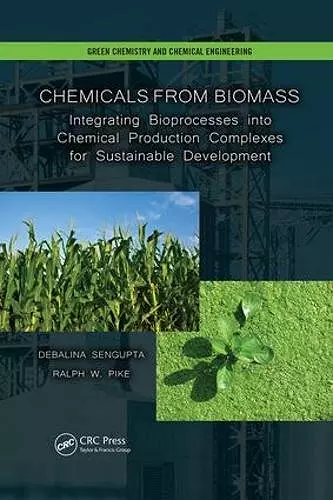Chemicals from Biomass
Integrating Bioprocesses into Chemical Production Complexes for Sustainable Development
Debalina Sengupta author Ralph W Pike author
Format:Paperback
Publisher:Taylor & Francis Ltd
Published:29th Mar '17
Currently unavailable, and unfortunately no date known when it will be back
This paperback is available in another edition too:
- Hardback£205.00(9781439878149)

Chemicals from Biomass: Integrating Bioprocesses into Chemical Production Complexes for Sustainable Development helps engineers optimize the development of new chemical and polymer plants that use renewable resources to replace the output of goods and services from existing plants. It also discusses the conversion of those existing plants into facilities that are based on renewable resources that may require nonrenewable resource supplements.
Relying on extensive reviews of biomass as feedstock and the production of chemicals from biomass, this book identifies and illustrates the design of new chemical processes (bioprocesses) that use renewable feedstock (biomass) as raw materials. The authors show how these new bioprocesses can be integrated into the existing plant in a chemical production complex to obtain the best combination of energy-efficient and environmentally acceptable facilities. This presented methodology is an essential component of sustainable development, and these steps are essential to achieving a sustainable chemical industry.
The authors evaluate potential bioprocesses based on a conceptual design of biomass-based chemical production, and they use Aspen HYSYS® and Aspen ICARUS® to perform simulations and economic evaluations of these processes. The book outlines detailed process designs created for seven bioprocesses that use biomass and carbon dioxide as feedstock to produce a range of chemicals and monomers. These include fermentation, transesterification, anaerobic digestion, gasification, and algae oil production. These process designs, and associated simulation codes, can be downloaded for modification, as needed. The methodology presented in this book can be used to evaluate energy efficiency, cost, sustainability, and environmental acceptability of plants and new products. Based on the results of that analysis, the methodology can be applied to other chemical complexes for new bioprocesses, reduced emissions, and energy savings.
"… this book’s detailed approach on a recent topic—biomass utilization—makes me interested and impressed as well. Especially, a plant simulation with optimization is a daunting task for any biochemical system. … the book deals with such a difficult task efficiently and in an easy way to make it acceptable."
—Dr. Chiranjib Bhattacharjee, Department of Chemical Engineering, Jadavpur University, Calcutta, India
"Overall, the book is well written and treats a timely subject with good breadth and depth, sufficient to make the material of practical use. Using biomass in existing chemical production complexes is important. The reason is that there is a great deal of chemical manufacturing infrastructure representing substantial capital that needs to be used gainfully. This makes the case studies very interesting."
—Heriberto Cabezas, U.S. EPA, Office of Research and Development, Cincinnati, Ohio, USA
"… this book’s detailed approach on a recent topic—biomass utilization—makes me interested and impressed as well. Especially, a plant simulation with optimization is a daunting task for any biochemical system. … the book deals with such a difficult task efficiently and in an easy way to make it acceptable."—Dr. Chiranjib Bhattacharjee, Department of Chemical Engineering, Jadavpur University, Calcutta, India
"Overall, the book is well written and treats a timely subject with good breadth and depth, sufficient to make the material of practical use. Using biomass in existing chemical production complexes is important. The reason is that there is a great deal of chemical manufacturing infrastructure representing substantial capital that needs to be used gainfully. This makes the case studies very interesting."—Heriberto Cabezas, U.S. EPA, Office of Research and Development, Cincinnati, Ohio, USA
ISBN: 9781138073340
Dimensions: unknown
Weight: 453g
506 pages